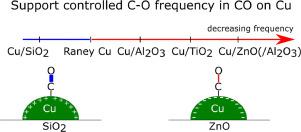当前位置:
X-MOL 学术
›
Surf. Sci.
›
论文详情
Our official English website, www.x-mol.net, welcomes your
feedback! (Note: you will need to create a separate account there.)
Characterization of oxide-supported Cu by infrared measurements on adsorbed CO
Surface Science ( IF 2.1 ) Pub Date : 2021-01-01 , DOI: 10.1016/j.susc.2020.121725 Niels D. Nielsen , Thomas E.L. Smitshuysen , Christian D. Damsgaard , Anker D. Jensen , Jakob M. Christensen
Surface Science ( IF 2.1 ) Pub Date : 2021-01-01 , DOI: 10.1016/j.susc.2020.121725 Niels D. Nielsen , Thomas E.L. Smitshuysen , Christian D. Damsgaard , Anker D. Jensen , Jakob M. Christensen

|
Abstract Infrared spectroscopy on CO chemisorbed on Raney Cu and materials with Cu dispersed as nanoparticles on oxide supports was used to evaluate support effects on the Cu surface properties. The C-O frequency (νC-O) is sensitive to the charge on the adsorption site with νC-O being high on Cu+, intermediate on Cu0, and low on Cu−, whereby this method can probe the charging state of the Cu surface. The Raney Cu reference demonstrates the complex analysis of the IR band intensity, which can be susceptible to dipole coupling. This means that the most intense IR bands may be higher frequency bands strengthened by such coupling effects rather than the bands arising from the most abundant sites. The νC-O of the major band attributable to CO adsorbed on the metallic surface follows the order: Cu/SiO2 > Raney Cu > Cu/Al2O3 > Cu/TiO2. Given the charge-frequency relationship these support-dependent frequency shifts are attributed to changes in the charging of the Cu surface caused by support effects. The Cu surface is more electron deficient for Cu/SiO2 and electron enriched for Cu/TiO2. For the Cu/ZnO(/Al2O3) samples, which are important as industrial methanol synthesis catalysts, band assignments are complicated by a low νC-O on Cu+ sites connected to the ZnO matrix. However, Cu/ZnO(/Al2O3) has a spectral feature at 2065-68 cm−1, which is a lower frequency than observed in the Cu single crystal studies in the literature and thus indicative of a negative charging of the Cu surface in such systems. Experiments with co-adsorption of CO and electron-withdrawing formate on Cu/ZnO and Cu/SiO2 show that νC-O in the adsorbed CO shifts upwards with increasing HCOO coverage. This illustrates that the surface charge is donated to the electron-withdrawing formate adsorbate, and as a result co-adsorbed CO experiences a more charge depleted Cu surface that yields higher νC-O. The support-dependent surface charging may thus affect the interaction with adsorbates on the metal surface and thereby impact the catalytic properties of the Cu surface. Dilution of the samples in KBr, which has been used in many studies in the literature, had pronounced effects on the spectra. The presence of KBr leads to an increase in νC-O indicative of an electron depleted surface attributed to transfer of electron-withdrawing bromine species from KBr to the sample.
中文翻译:

通过对吸附的 CO 的红外测量表征氧化物负载的铜
摘要 雷尼铜上化学吸附的一氧化碳和以纳米粒子形式分散在氧化物载体上的铜材料的红外光谱被用来评估载体对铜表面性质的影响。CO频率(νC-O)对吸附位点的电荷敏感,νC-O在Cu+上高,在Cu0上中等,在Cu-上低,因此该方法可以探测Cu表面的充电状态。Raney Cu 参考文献展示了对 IR 波段强度的复杂分析,该强度容易受到偶极子耦合的影响。这意味着最强烈的 IR 波段可能是由这种耦合效应加强的更高频段,而不是来自最丰富站点的波段。归因于金属表面吸附 CO 的主带 νC-O 遵循以下顺序:Cu/SiO2 > Raney Cu > Cu/Al2O3 > Cu/TiO2。鉴于电荷-频率关系,这些依赖于载体的频移归因于由载体效应引起的 Cu 表面充电的变化。Cu/SiO2 的 Cu 表面更缺乏电子,而 Cu/TiO2 的电子富集。对于作为工业甲醇合成催化剂很重要的 Cu/ZnO(/Al2O3) 样品,由于连接到 ZnO 基质的 Cu+ 位点上的低 νC-O,谱带分配变得复杂。然而,Cu/ZnO(/Al2O3) 在 2065-68 cm-1 处具有光谱特征,这比文献中的 Cu 单晶研究中观察到的频率低,因此表明在这种情况下 Cu 表面带负电荷。系统。CO 和吸电子甲酸盐在 Cu/ZnO 和 Cu/SiO2 上的共吸附实验表明,吸附的 CO 中的 νC-O 随着 HCOO 覆盖率的增加而向上移动。这说明表面电荷被捐赠给吸电子的甲酸盐吸附物,因此共吸附的 CO 经历更多电荷耗尽的 Cu 表面,产生更高的 νC-O。因此,依赖于载体的表面电荷可能会影响与金属表面吸附物的相互作用,从而影响 Cu 表面的催化性能。在文献中的许多研究中都使用了 KBr 中的样品稀释,对光谱有明显的影响。KBr 的存在导致 νC-O 增加,表明由于吸电子溴物质从 KBr 转移到样品中导致的电子耗尽表面。因此,共吸附的 CO 会经历更多电荷耗尽的 Cu 表面,从而产生更高的 νC-O。因此,依赖于载体的表面电荷可能会影响与金属表面吸附物的相互作用,从而影响 Cu 表面的催化性能。用 KBr 稀释样品(已在文献中的许多研究中使用)对光谱有显着影响。KBr 的存在导致 νC-O 增加,表明由于吸电子溴物质从 KBr 转移到样品中导致的电子耗尽表面。因此,共吸附的 CO 会经历更多电荷耗尽的 Cu 表面,从而产生更高的 νC-O。因此,依赖于载体的表面电荷可能会影响与金属表面吸附物的相互作用,从而影响 Cu 表面的催化性能。在文献中的许多研究中都使用了 KBr 中的样品稀释,对光谱有明显的影响。KBr 的存在导致 νC-O 增加,表明由于吸电子溴物质从 KBr 转移到样品中导致的电子耗尽表面。对光谱有显着影响。KBr 的存在导致 νC-O 增加,表明由于吸电子溴物质从 KBr 转移到样品中导致的电子耗尽表面。对光谱有显着影响。KBr 的存在导致 νC-O 增加,表明由于吸电子溴物质从 KBr 转移到样品中导致的电子耗尽表面。
更新日期:2021-01-01
中文翻译:

通过对吸附的 CO 的红外测量表征氧化物负载的铜
摘要 雷尼铜上化学吸附的一氧化碳和以纳米粒子形式分散在氧化物载体上的铜材料的红外光谱被用来评估载体对铜表面性质的影响。CO频率(νC-O)对吸附位点的电荷敏感,νC-O在Cu+上高,在Cu0上中等,在Cu-上低,因此该方法可以探测Cu表面的充电状态。Raney Cu 参考文献展示了对 IR 波段强度的复杂分析,该强度容易受到偶极子耦合的影响。这意味着最强烈的 IR 波段可能是由这种耦合效应加强的更高频段,而不是来自最丰富站点的波段。归因于金属表面吸附 CO 的主带 νC-O 遵循以下顺序:Cu/SiO2 > Raney Cu > Cu/Al2O3 > Cu/TiO2。鉴于电荷-频率关系,这些依赖于载体的频移归因于由载体效应引起的 Cu 表面充电的变化。Cu/SiO2 的 Cu 表面更缺乏电子,而 Cu/TiO2 的电子富集。对于作为工业甲醇合成催化剂很重要的 Cu/ZnO(/Al2O3) 样品,由于连接到 ZnO 基质的 Cu+ 位点上的低 νC-O,谱带分配变得复杂。然而,Cu/ZnO(/Al2O3) 在 2065-68 cm-1 处具有光谱特征,这比文献中的 Cu 单晶研究中观察到的频率低,因此表明在这种情况下 Cu 表面带负电荷。系统。CO 和吸电子甲酸盐在 Cu/ZnO 和 Cu/SiO2 上的共吸附实验表明,吸附的 CO 中的 νC-O 随着 HCOO 覆盖率的增加而向上移动。这说明表面电荷被捐赠给吸电子的甲酸盐吸附物,因此共吸附的 CO 经历更多电荷耗尽的 Cu 表面,产生更高的 νC-O。因此,依赖于载体的表面电荷可能会影响与金属表面吸附物的相互作用,从而影响 Cu 表面的催化性能。在文献中的许多研究中都使用了 KBr 中的样品稀释,对光谱有明显的影响。KBr 的存在导致 νC-O 增加,表明由于吸电子溴物质从 KBr 转移到样品中导致的电子耗尽表面。因此,共吸附的 CO 会经历更多电荷耗尽的 Cu 表面,从而产生更高的 νC-O。因此,依赖于载体的表面电荷可能会影响与金属表面吸附物的相互作用,从而影响 Cu 表面的催化性能。用 KBr 稀释样品(已在文献中的许多研究中使用)对光谱有显着影响。KBr 的存在导致 νC-O 增加,表明由于吸电子溴物质从 KBr 转移到样品中导致的电子耗尽表面。因此,共吸附的 CO 会经历更多电荷耗尽的 Cu 表面,从而产生更高的 νC-O。因此,依赖于载体的表面电荷可能会影响与金属表面吸附物的相互作用,从而影响 Cu 表面的催化性能。在文献中的许多研究中都使用了 KBr 中的样品稀释,对光谱有明显的影响。KBr 的存在导致 νC-O 增加,表明由于吸电子溴物质从 KBr 转移到样品中导致的电子耗尽表面。对光谱有显着影响。KBr 的存在导致 νC-O 增加,表明由于吸电子溴物质从 KBr 转移到样品中导致的电子耗尽表面。对光谱有显着影响。KBr 的存在导致 νC-O 增加,表明由于吸电子溴物质从 KBr 转移到样品中导致的电子耗尽表面。











































 京公网安备 11010802027423号
京公网安备 11010802027423号